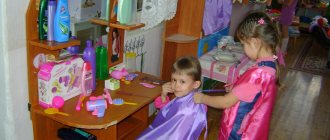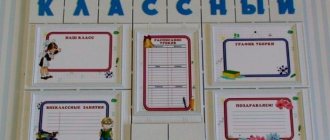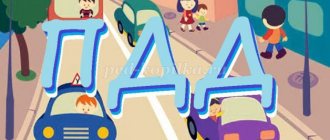The role of the group passport in the educational process in kindergarten
A group passport in a preschool institution is a document containing information about the group’s students, technological equipment, teaching staff, daily routine and class schedule. All this allows parents, team members and administrative educational organizations to obtain the most accurate and complete information about the group.
The passport reflects the main moments of the group’s life: who works with the students, in what conditions the children develop, what services are provided by the educational institution.
The group passport can be presented to parents during the meeting.
Goals and objectives of group certification
The main task of the group passport is to competently display the working structure, conditions and content of the group, individual circles, offices, development zones, and halls in the preschool educational institution. The main goal is to regulate and create an enriched subject-development environment, individually for each age group of students.
Group certification tasks:
- enrichment and addition of the subject-spatial environment in accordance with the level of development of kindergarten students;
- ensuring variability of the developing subject-spatial environment in educational areas of the main educational program of preschool education of preschool educational institutions (social and communicative development, cognitive development, speech development, artistic and aesthetic development, physical development);
- designing a unified educational space for preschool educational institutions in accordance with preschool education programs.
A group (office) passport is drawn up at the beginning of the academic year. In some cases, re-certification is allowed.
Types of passports in preschool educational institutions
There are several types of passports for groups:
- Social (information about children, their level of physical and mental development).
- Educational (plan of the educational process, daily routine for cold and warm seasons, main educational tasks for the current year).
- Technical (information about the presence in the group of the necessary furniture, items for games, various areas for games and activities, educational materials, area of rooms and their number).
- Passports of music, physical education, dance halls (information about the teacher responsible for the room or hall, the size of the room, the necessary equipment).
- Methodological classroom passport (general information about the premises, information about development zones and equipment, books and filing cabinets, classroom plan).
There are also passports common to preschool educational institutions, containing information about employees, fire safety, rules of behavior on the roads, general information about the kindergarten, its layout, subject equipment, and additional educational services.
Video: passport of the group “Romashki”
Passport of the senior group math corner
Do-it-yourself group decoration in kindergarten
Passport of the "Daisies" group of the "Mathematical Corner "
An indispensable condition for the development of children's mathematical creativity is an enriched subject-spatial environment.
This is, first of all, the presence of interesting educational games, a variety of gaming materials, as well as games and entertaining mathematical material. The main purpose of using entertaining material is to form ideas and consolidate existing knowledge. In this case, an indispensable condition is the teacher’s use of games and exercises for the active manifestation of cognitive independence in children: the desire and ability to learn, to carry out effective mental operations. Game materials:
- “Columbus Egg” - “Geocont” - “Tangram” - “Dienesh Logic Blocks”
Handouts
*flat – set of flowers, insects, etc.
geometric shapes * volumetric - cucumbers tomatoes Christmas trees mushrooms geometric shapes * counting sticks * faiths with numbers up to 20 Didactic games
: “Make a figure” “Fold a pattern” “Drawing and construction” “Draw a picture with sticks” “Cut pictures” “Funny strings”
Tabletop - printed and educational games:
“Mosaic” “Shimmering Mosaic” “Pick a Pattern” “Funny Train” “Logical Train” “My First Numbers” “Colors” “Geometric Shapes”
Lotto
“Couples”: “Flowers” “Animals”
Materials for individual development
- mathematical house with lids - multi-storey mathematical house - cards "funny math problems" - tag - rubik's cube - snake - adding machines - abacus - puzzles - lotto - dominoes
Coloring pages:
"shape" "fun recess" "smart coloring" “draw by dots and color” “draw by cells” “connect by dots” “labyrinths” “make a picture” Card index of
games Information for parents And I also suggest that you get acquainted with our math corner visually I hope that when organizing and designing a math corner in your group, my material will become useful for you!
We recommend watching:
Didactic games and exercises in mathematics for children 4 - 6 years old Do-it-yourself spring decoration of a group in a kindergarten Do-it-yourself nature corner in a kindergarten group Do-it-yourself speech development center in a preparatory group
Similar articles:
Math tasks in pictures for children 6-7 years old
Exercises with counting sticks for preschoolers
Teaching mathematics using the Nikitin method
Math problems jokes for preschoolers
Mathematical riddles for preschoolers in verse with answers
Zoning in kindergarten
Perhaps, when planning play areas in a preschool educational institution according to the Federal State Educational Standard, one should, first of all, take into account the age of the children and their number. It is also worth finding out the opinion of parents: by asking what they want to see in the group, this will not only show your interest, attention and respect, but also, most likely, you will find proactive helpers.
For convenience, transfer all original ideas for designing a group in a kindergarten to a drawing plan, be sure to indicate on it the names of the corners and their locations.
Depending on the vastness of the space, zoning in a kindergarten group can be quite rich. Below are the most popular zones in the kindergarten group according to the Federal State Educational Standard. Select and organize those that will correspond to your current goals and objectives for the development and upbringing of children.
Zoning in the preparatory group of kindergarten
Outdoor games area
Physical education plays a vital role in the development of children, and it is also important to remember this when planning the design of a kindergarten. Of course, modern kindergartens have gyms and swimming pools, but it is still worthwhile to provide a mini-health corner in the group. This area should be spacious enough. Children should be able to run and jump. A gymnastic wall and various sports equipment would be appropriate here: hoops, balls, skittles, jump ropes. However, we must not forget that the equipment must be appropriate for the age of the children.
Role-playing games area
The design of play areas in a kindergarten provides wide scope for creativity for their organizer. There should, of course, be a lot of toys here. But among their number, children must be able to navigate. Therefore, it is necessary to make themed corners. Separately, you can organize a hairdresser with a chair, dolls and toy tools; hospital, where there will be white coats and medical supplies. You can also create a kitchen corner for girls in kindergarten. To organize it, a toy stove, dishes, food, an apron and a chef's hat, as well as dolls in aprons, are suitable.
Girls, with their favorite games of mother-daughter, tea party or shopping, will feel cozy in a special playhouse. Be sure to post it if possible.
There is also a place for boys in the playhouse; they will be the ones who will come to visit and learn the basics of etiquette. Their play area can be placed nearby and its design can be approached in an equally original way, for example, by making an impromptu garage, where there will be cars of different sizes and purposes: trucks, cars, dump trucks, buses, ambulances, police and fire departments. A railway could also be built here. You can also make a small repair shop corner with toy hammers, nuts, screws and other supplies.
Correctly designing areas in a kindergarten is an excellent opportunity for a teacher to unobtrusively show children the basics of adult life: what and how to cook with, how to properly receive guests, take care of younger children, and much more.
Study area in kindergarten
In the learning corner there must be a table at which several children can be seated at the same time. There they can draw, make crafts, learn to read, count and play relaxing board games.
The filling and design of the learning area in kindergarten should take into account the age of the children. Place here cubes, mosaics, various kinds of construction sets that do not contain small parts, educational and educational board games - here kids can practice, developing fine motor skills and expanding their knowledge about the world around them. Don't forget to allocate space for the simplest geometric shapes, shapes of different colors.
The safety corner can be placed separately or, if group space does not allow, it can be made part of the study area. Post here information about traffic rules, fire safety, and standards of behavior indoors and outdoors.
Social Development Zone
The previous zone can be separated by a bookcase or bookcases, combining with a social development corner and a book corner. It is advisable to locate this area away from the place of noisy games, because, being distracted, the child will not be able to concentrate on communicating with the book. The corner should be well lit and have a place where the baby can sit and leaf through a book.
Through a book, a child learns a whole range of human feelings, thoughts, and relationships between characters. By identifying himself with a hero, a child takes on a certain model of behavior, which he tries to follow throughout his life. It is necessary to provide a corner with various books appropriate to the age category of children. There should be fairy tales, instructive stories, books about nature, as well as educational books. The corner should be regularly replenished with new interesting and colorful specimens, thereby maintaining children’s interest in it.
In the social development zone there is a place not only for books, but also for a small family history of each child. Try inviting parents and children to choose photos for small family albums that they can proudly show to friends when talking about family, important events or travel.
Corner of nature
There is no doubt that designing a corner of nature in a kindergarten is an excellent basis for introducing a child to natural phenomena.
In the younger group, as a rule, the corner of nature is limited to indoor plants, but for children in the older group it will be much more interesting to study the calendar, the change of seasons, natural phenomena, parts of plants and trees.
The theme of the corner of nature deserves special attention. It is much more interesting when the exhibition changes, for example, once a quarter, then such a corner of the group will attract much more attention from the child. As winter approaches, it is useful to fill it with information on caring for birds at this time, for example, display photographs of wintering birds, perhaps build a feeder with children in labor lessons.
Creating a greenhouse is also of no small importance. Using the example of different types of plants, the child will understand that plants are different, that not all have a stem, but they all have roots, and the leaves can be of different shapes. You can add butterflies or dragonflies to your greenhouse, which children can make on their own. And if the pots with plants are labeled, it will be doubly educational. In the summer, a corner of nature can be supplemented with living garden or field plants or flowers, and in the fall with the fruits that nature gave.
The living inhabitants of the natural corner in the kindergarten will deserve special interest among the children. There could be a cage with a hamster or an aquarium with fish, and kids can be taught the basics of caring for animals. Before getting a pet, you must obtain the consent of all parents, be sure to ask adults if their children have allergies, and do not forget about a certificate from a veterinarian.
Preschool institutions, as a rule, do not effectively use the area in front of the kindergarten. Quite rarely, children are involved in landscaping the site, where corners such as vegetable gardens, flower beds, and corners of the garden have been created, which can be used to develop the basics of environmental consciousness in the child.
Music Development Zone
A music corner in kindergarten will help to reveal creative talents and increase the overall level of education. If it is not possible to place children's musical instruments there, limit yourself to pictures and a player.
Patriotic education zone
And in cultivating a love of work and patriotism, a local history corner will be a faithful assistant, in which there will be a place for objects of applied art and folk crafts that are popular in your area. Also, be sure to place symbols and portraits of the heads of state and your region here. This area will be especially decorated with dolls in national costumes, even if they are cut out of paper.
Creative Development Zone
The real decoration and pride of the kindergarten group is the children's creativity corner. The children’s works are not only aesthetic in nature, but also stimulate the child to achieve further success and serve as a clear example of the interaction between the teacher and the child.
Creative corners in the group, as a rule, are limited to an exhibition of children's works and crafts. But this is not the only function they can perform. For example, you can organize educational corners in preschool educational institutions dedicated to the work of various people, for example, famous artists or composers.
It is not necessary to use a small space for a creativity corner. For example, when preparing for the New Year, you can cut out and decorate the entire group with snowflakes: thus, you will get a “children’s creativity room.” And if you decorate the Christmas tree with homemade toys, you will get a “Christmas tree of children’s creativity.”
Children love to do things with their own hands; they always try and are happy with the result, if it also turns out to be satisfactory. And if there is an opportunity to decorate and display works in a different way, then you should not limit yourself to just a corner of creativity.
When forming zones in a preschool educational institution according to the Federal State Educational Standard, remember that the main requirement for the environment and design of a group in a kindergarten is safety. Avoid sharp corners, slippery floors, and ensure that wall shelves or decorative items are securely attached.
Approach space planning and design of activity areas in kindergarten creatively and with love, and you will definitely have a cozy group where both children and their parents will be happy to come every day!







